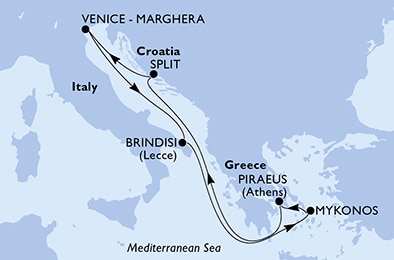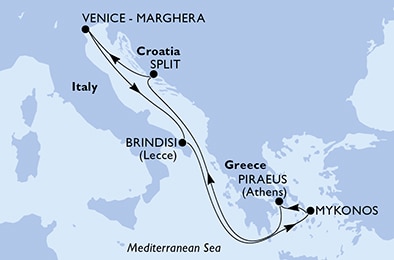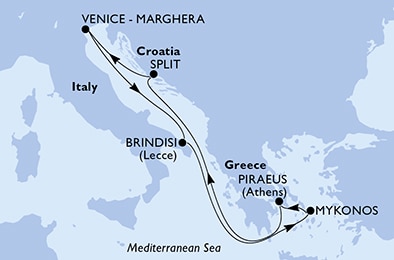
Port Brindisi (Lecce)
Brindisi, located in the southern region of Puglia, Italy, is a historic port city that has played a significant role as a gateway to the Adriatic and beyond. Known as the "Door to the East," Brindisi has been a vital hub for trade and travel since ancient times, serving as the terminus of the Via Appia, one of the most important Roman roads. Visitors can explore landmarks like the Roman Column, which marks the end of the Via Appia, and the Castello Svevo (Swabian Castle), a medieval fortress built by Emperor Frederick II. The Cathedral of Brindisi, located in Piazza Duomo, is another must-see, embodying the city's rich history and architectural beauty.
Beyond its historical appeal, Brindisi boasts a picturesque waterfront with lively promenades and stunning views of the Adriatic Sea. The city's proximity to beautiful beaches, such as those in Torre Guaceto Nature Reserve, makes it a perfect destination for relaxation and nature lovers. Brindisi is also known for its delicious Apulian cuisine, featuring seafood delicacies, orecchiette pasta, and local wines. With its combination of historic sites, coastal charm, and culinary delights, Brindisi is a captivating destination in the heart of the Mediterranean.
History
Brindisi, a historic port city in the Apulia (Puglia) region of southern Italy, has been a vital maritime hub since ancient times. Its name originates from the Messapian word "Brentesion," meaning "deer head," due to the shape of its natural harbor. During the Roman Empire, Brindisi flourished as a key gateway to the East, serving as the western terminus of the Via Appia, the famous Roman road connecting the city to Rome. The port was instrumental in trade and military expeditions to Greece and the Eastern Mediterranean, solidifying Brindisi's strategic importance in antiquity.
In the Middle Ages, Brindisi was contested by various powers, including the Byzantines, Normans, and Swabians, each leaving their mark on the city. The Cathedral of Brindisi and the Aragonese Castle are prominent reminders of its medieval heritage. During the 19th and 20th centuries, Brindisi regained significance as a naval and commercial port. Today, the city is celebrated for its historical landmarks, such as the Roman Columns marking the end of the Via Appia, and its modern role as a connection point to Greece and the Balkans, blending ancient legacy with contemporary relevance.





 With bus transport to the port
With bus transport to the port






